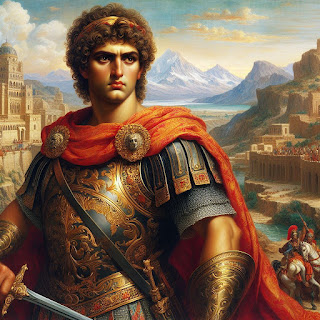Foreign Invasions
image sources https://en.wikipedia.org/wiki/Alexander_the_Great
Iranian/ Persian Invasion
The archaemenian ruler of Iran, took advantages of the political disunity of the North-west frontier of India.
- Cyrus of Persia (588 BC – 530 BC) was the first foreign conqueror who penetrated well into India. He destroyed the city of Capisa. He enrolled Indian soldier in the Persian Army.
- Darius- 1 grandson of Cyrus invaded North-West India in 516 BC and annexed Punjab, West of Indus and Sind.
- Xerxes the successor of Darius employed Indians in the long war against Greeks.
Effect of Iranian Invasion.
- It gave an impetus to Indo-Iranian trades and commerce.
- There was cultural exchange in the form of Kharoshthi script from Iran to India. Some of Asoka’s inscriptions in North-West India were written, in this script.
- Iranian influence is perceptible in sculpture e.g. the bell-shaped capitals.
- The Iranian or Persian invasions introduced and facilitated the spread of Islam in India.
- While Zoroastrianism, the religion of the Achaemenid Empire, did not gain widespread acceptance, Islam became a major religion in India, coexisting with Hinduism, Buddhism, and other indigenous religions.
- The establishment of Persianate states, such as the Delhi Sultanate and the Mughal Empire, transformed the political landscape of India and influenced its governance structures.
- Cities like Delhi, Lahore, and Agra became major centers of trade, commerce, and cultural exchange between Iran, Central Asia, and India.
- The use of gunpowder and artillery, introduced by the Mughals, revolutionized Indian warfare and military architecture.
Alexander’s The Great
Alexander’s Invasion
- Alexander the Great was a great king and general who conquered the Persian Empire.
- From Iran he marched towards India, attracted by its great wealth and divided polity.
- Alexander succeeded his father Philip to the throne of Macedonia. He was then only 20 years of Age.
- From his childhood he used to dream of world conquest. He quickly conquered many areas.
- As a preliminary step to conquer India, the Kabul valley and the hilly area of North-West frontier were conquered and he reached Ohind near Attock in 326 BC.
- The rulers of Taxila and Abhisara submitted but Porus refused to do so.
- Alexander then crossed the Jhelum by a trick. Porus was defeated in the battle that followed but Alexander treated him very generously for his bravery.
- This was how the Indians were defeated because of their disunity
- After a brilliant victory at Sakala, the Greek forces reaches the Beas. Alexander had to return from this place as his soldiers refused to go any further the battle of Jhelum and Sakala had opened their eyes and they were afraid of the great Magadhan Empire across the Beas.
- After making some administrative arrangements for the conquered territory, Alexander marched back in Sep. 325 BC.
- He reached Babylon in 323 BC where he died at the age of 33.
- When Alexander died no one was able to keep newly won empire together. After years of war among his generals it was split up into smaller kingdoms Macedonia, Babylonia and Egypt.
Impacts of Alexander’s Invasion
Opening up of mew trade routes between North-West India and Western Asia. Indians learnt from the Greeks in the fields of coinage, astronomy architecture and sculpture.
Introduction of Greek Influence:
- Alexander's invasion introduced Greek influence to the Indian subcontinent, especially in the regions of Punjab and the Indus Valley.
- This led to a cultural exchange between Greek and Indian civilizations, resulting in a blend of artistic, architectural, and philosophical ideas.
Interaction with Indian Kingdoms:
- Alexander encountered several powerful Indian kingdoms, most notably the Nanda Empire and the Magadha Empire.
- These interactions influenced the political dynamics of the region and set the stage for future interactions between Greek and Indian rulers.
Spread of Hellenistic Culture:
- The areas conquered by Alexander became part of the Hellenistic world, leading to the spread of Greek culture, language, and customs.
- Greek colonies were established in some regions, contributing to the synthesis of Greek and Indian cultures.
Military and Strategic Impact:
- Alexander's military campaign in India demonstrated the effectiveness of his tactics and strategies against Indian armies.
- The knowledge gained from these encounters may have influenced later military campaigns and strategies in the region.
- The interaction between Greek and Indian cultures resulted in a cultural synthesis, with influences seen in art, architecture, and literature.
- Buddhist art and Gandhara art, which combine Greek and Indian elements, emerged during this period.
Historical Records and Documentation:
- Alexander's invasion of India is well-documented in both Greek and Indian historical texts, providing valuable insights into the political and cultural landscape of the time.
- Greek accounts, such as those by historians like Arrian and Plutarch, offer a unique perspective on the Indian subcontinent during this period.
- Despite initial successes, Alexander faced significant resistance from local rulers and tribes in India.
- The Indian campaign highlighted the resilience and military prowess of Indian kingdoms, setting a precedent for future resistance against foreign invasions.

.png)


